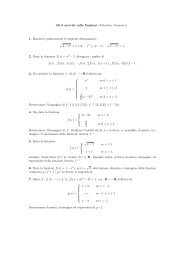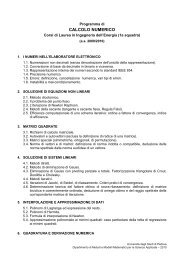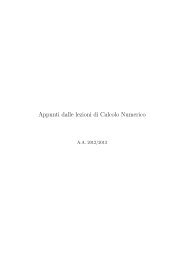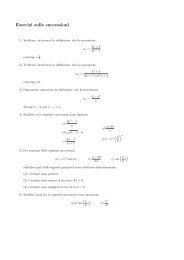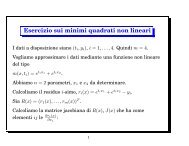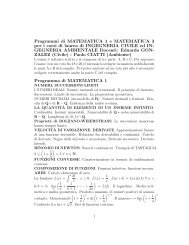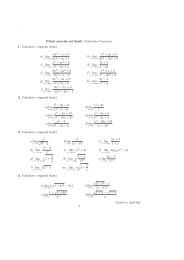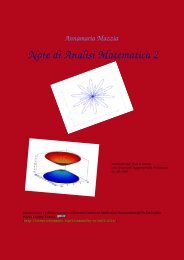Appunti di Calcolo Numerico - Esercizi e Dispense - Università degli ...
Appunti di Calcolo Numerico - Esercizi e Dispense - Università degli ...
Appunti di Calcolo Numerico - Esercizi e Dispense - Università degli ...
You also want an ePaper? Increase the reach of your titles
YUMPU automatically turns print PDFs into web optimized ePapers that Google loves.
3.7. Instabilità e malcon<strong>di</strong>zionamento<br />
Esempio<br />
Esempio 3.7.1 Consideriamo l’integrale<br />
∫ 1<br />
x n<br />
y n =<br />
0 x + 10 dx<br />
per valori <strong>di</strong> n = 1,2,...,30. Osserviamo che, poichè x ∈ [0,1], la funzione integranda varia pure essa<br />
nell’intervallo [0,1] per cui 0 < y n < 1.<br />
Analiticamente, si ha:<br />
∫ 1<br />
x n + 10x n−1 ∫ 1<br />
x n−1 (x + 10)<br />
y n + 10y n−1 =<br />
dx =<br />
dx =<br />
0 x + 10<br />
0 x + 10<br />
Vale anche la relazione<br />
y 0 =<br />
∫ 1<br />
0<br />
1<br />
dx = ln(11) − ln(10).<br />
x + 10<br />
∫ 1<br />
0<br />
x n−1 dx = 1 n<br />
Possiamo pensare, quin<strong>di</strong>, <strong>di</strong> calcolare numericamente il valore <strong>di</strong> y n attraverso il seguente algoritmo:<br />
1. valutare y 0 = ln(11) − ln(10)<br />
2. per n = 1,2,...,30 valutare y n = 1 n − 10y n−1<br />
Questa formula ricorsiva darebbe l’esatto valore se non fossero presenti errori <strong>di</strong> arrotondamento che ci<br />
allontanano completamente dalla soluzione vera. L’errore si moltiplica esponenzialmente. Infatti<br />
y 1 = 1 − 10y 0<br />
y 2 = 1 2 − 10(1 − 10y 0) = 1 2 − 10 + (−10)2 y 0<br />
y 3 = 1 3 − 10( 1 2 − 10 + 102 y 0 ) = −10 3 y 0 + cost ante<br />
. . . .<br />
y n = (−10) n y 0 + cost ante n<br />
L’algoritmo quin<strong>di</strong>, considerati gli errori <strong>di</strong> arrotondamento, presenta un errore E n con crescita <strong>di</strong> tipo<br />
esponenziale. Difatti otteniamo valori che via via si allontanano dall’intervallo <strong>di</strong> ammissibilità [0,1].<br />
I risultati che ricaviamo sono i seguenti (osserviamo che sono leggermente <strong>di</strong>versi a seconda dal<br />
linguaggio usato, proprio per effetto dell’instabilità).<br />
Da un programma in Fortran:<br />
Da un programma Matlab:<br />
n y n<br />
0 9.5310e-2<br />
1 4.6898e-2<br />
2 3.1021e-2<br />
3 2.3122e-2<br />
4 1.8778e-2<br />
... ....<br />
7 -3.0229e-1<br />
8 3.1479e+0<br />
9 -3.1368e+1<br />
10 3.1378e+2<br />
18 3.1377e+10<br />
27 -3.1377e+19<br />
30 3.1377e+22<br />
n y n<br />
0 9.5310e-2<br />
1 4.6898e-2<br />
2 3.1018e-2<br />
3 2.3154e-2<br />
4 1.8465e-2<br />
... ....<br />
7 1.1481-2<br />
8 1.0194e-2<br />
9 9.1673e-3<br />
10 8.3270e-3<br />
18 -9.1694e+1<br />
27 -9.1699e+9<br />
30 -9.1699e+13<br />
33



